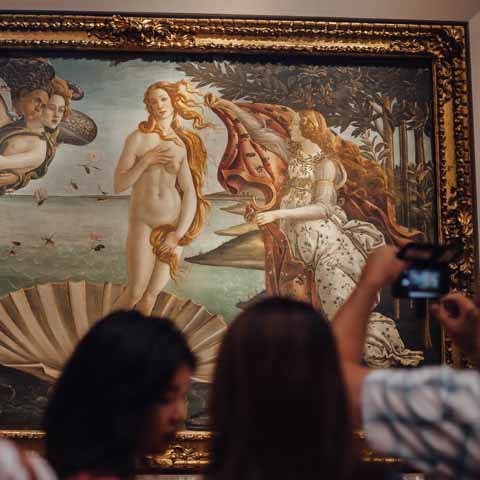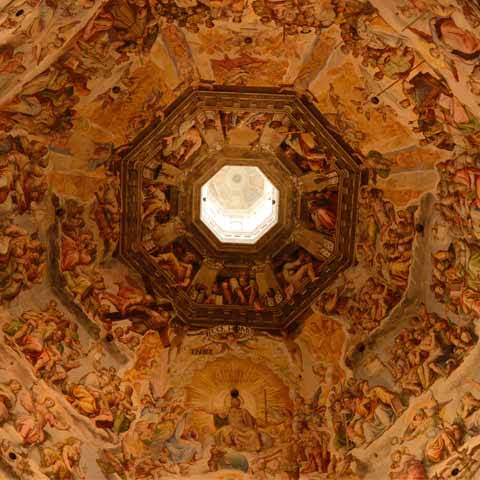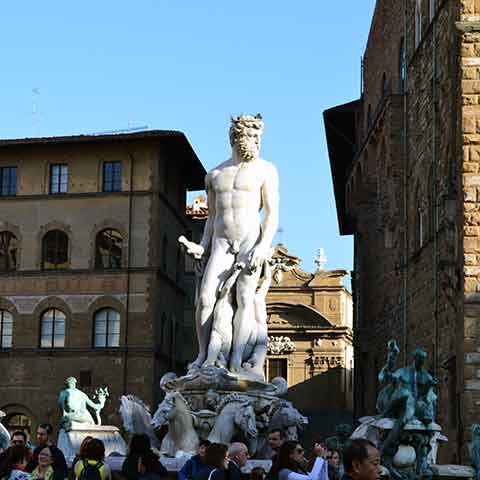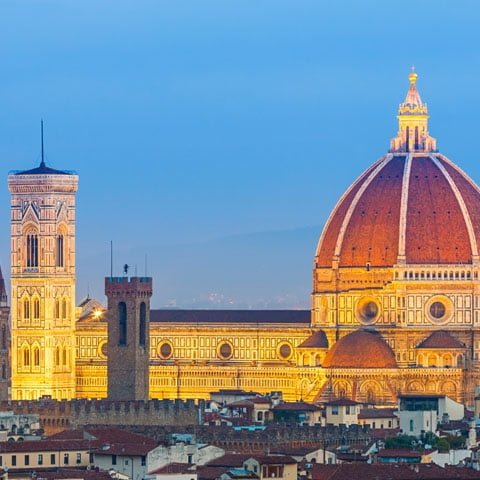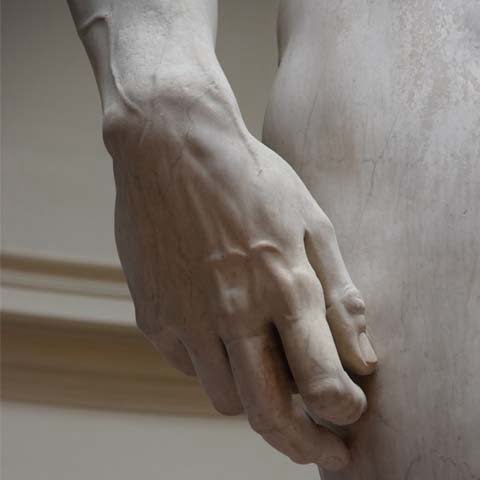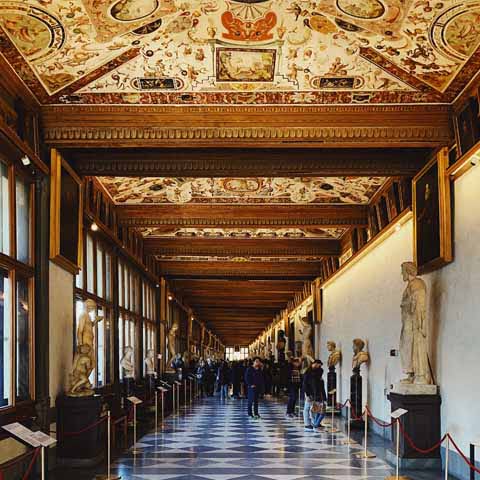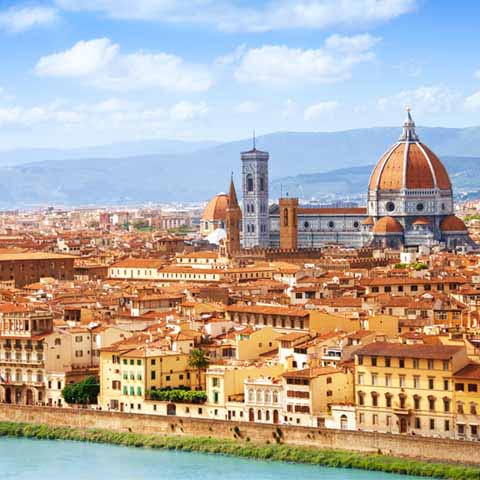 As the Cradle of the Renaissance and home to some of the world’s best in art, fashion, food, and architecture, the culture of Florence, like the rest of Italy, is absolutely brimming with culture. What sets Florence apart, however, can be summed up in two words that best encapsulate what the city offers – unparalleled beauty.
As the Cradle of the Renaissance and home to some of the world’s best in art, fashion, food, and architecture, the culture of Florence, like the rest of Italy, is absolutely brimming with culture. What sets Florence apart, however, can be summed up in two words that best encapsulate what the city offers – unparalleled beauty.
The city itself stuns with its many gorgeous architectural and landscape elements. The city’s luxury fashion designers – Gucci, Salvatore Ferragamo, and Roberto Cavalli – create exquisite clothing and accessories that help influence the beauty of modern fashion worldwide. The art pieces held within Florence’s many museums and art galleries depict unparalleled beauty. It could even be argued that the artistic ideal for male and female beauty was established by Michelangelo’s statue of David and Botticelli’s Venus, both of which remain in Florence and continue to influence our conception of beauty.
The city is so filled with beauty, in fact, that many visitors are overwhelmed, such as nineteenth century French writer Stendhal. According to Stendhal, while he was admiring the Basilica of Santa Croce during a trip to Florence in 1817, he experienced heart palpitations and felt dizzy. It is believed that others may experience similar symptoms when viewing Florence’s treasures, and in 1979 the syndrome was given a name: Stendhal syndrome. This disorder purportedly causes rapid heartrate, dizziness, and fainting at the site of tremendous beauty – particularly art. Though there is still some speculation as to whether the disorder is real or not, there is no doubt that Florence is ripe with overwhelming beauty that stuns visitors and locals alike.
In addition to its classification as immensely beautiful, Florence can also be described as rich in culture. As the birthplace of the Italian Renaissance, one of the world’s most important and influential cultural movements, the city has a cornucopia of cultural elements in its art scene, architecture, and within its history.
ART: CULTURE OF FLORENCE
Thanks to its rich history and role in the Italian Renaissance art movement, Florence boasts some of the world’s most cherished works of art throughout its many museums and galleries. The Galleria dell’Accademia (Accademia Gallery), Galleria degli Uffizi (Uffizi Gallery), the Bargello Museum, and the Pitti Palace are four key locations to admire legendary Italian Renaissance art pieces and experience the history of Florence firsthand.
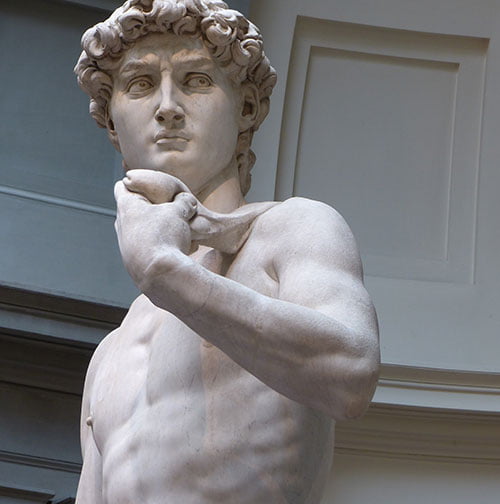 When it comes to sculptures, the best places to visit are the Accademia Gallery – home to Michelangelo’s statue of David – and the Bargello Museum, which is considered to contain the most comprehensive collection of Renaissance sculptures in Italy. In addition to the David, the famed Accademia Gallery is also home to several unfinished sculptures by Michelangelo, which, when viewed together with David, provide fascinating insight into Michelangelo’s creative process. Meanwhile, the Bargello Museum, which was Italy’s first national museum, is housed in a historic building that once served as a prison. Today visitors can admire remarkable sculptures by the likes of Michelangelo, Donatello, Giambologna, Benvenuto Cellini, Lorenzo Ghiberti, and Bartolomeo Ammannati.
When it comes to sculptures, the best places to visit are the Accademia Gallery – home to Michelangelo’s statue of David – and the Bargello Museum, which is considered to contain the most comprehensive collection of Renaissance sculptures in Italy. In addition to the David, the famed Accademia Gallery is also home to several unfinished sculptures by Michelangelo, which, when viewed together with David, provide fascinating insight into Michelangelo’s creative process. Meanwhile, the Bargello Museum, which was Italy’s first national museum, is housed in a historic building that once served as a prison. Today visitors can admire remarkable sculptures by the likes of Michelangelo, Donatello, Giambologna, Benvenuto Cellini, Lorenzo Ghiberti, and Bartolomeo Ammannati.
Located in the Oltrarno area near the Ponte Vecchio, the Pitti Palace holds much of the Medici family’s extensive art collection. As the former residence of the Medici family, the palace is large and richly decorated. The Pitti Palace museum complex consists of the Palatine Gallery that displays works by Raphael and Titian as well as the Royal Apartments, the Gallery of Modern Art, the Treasury of the Grand Dukes, a Fashion Museum, a Porcelain Museum, and a Carriage Museum. The verdant Boboli Gardens, which span 11 acres and are home to historic statues, are positioned behind the Pitti Palace. Notably, the Pitti Palace is connected to the Uffizi Gallery via the Vasari Corridor. Arguably the world’s most famous art museum, the Uffizi, contains many key masterpieces from the Late Middle Ages and Italian Renaissance, including works by such artists as Giotto, Leonardo da Vinci, Michelangelo, Botticelli, Titian, Simone Martini, Raphael, Caravaggio, Fra Angelico, Filippo Lippi, Mantegna, Antonio da Correggio, Piero della Francesca, Albrecht Dürer, and Rembrandt. With such a large collection of important art, it is not uncommon to get lost in the many treasures of the Uffizi Gallery.
In addition to housing priceless pieces of art, Florence also served as the birthplace to some of the world’s greatest and most influential artists. Botticelli, Donatello, Cimabue, and Benvenuto Cellini all hailed from Florence and made indelible marks on the world of art in their own unique ways.
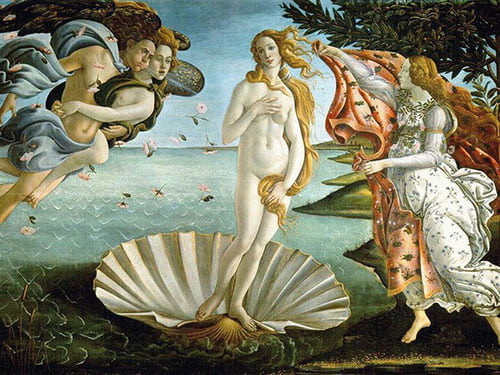
Botticelli, one of the greatest Italian painters, is responsible for masterpieces such as The Birth of Venus and Primavera. Donatello was a sculptor who is widely praised for his incredibly detailed pieces including St. George and David, both of which are on display at the Bargello Museum. Cimabue and Cellini were also painters and sculptors, respectively, and are well known for their incredible creations. Cimabue was among the first painters in Italy to create art outside of the classic Byzantine style, influencing other artists such as Giotto and Duccio, while, several centuries later, Cellini was a master of the Mannerist style.
Florence may be best known around the world for its historic medieval and Renaissance art, yet artistic traditions are alive and well in the city, and Florence happens to serve as a hub for contemporary art too. Some of Florence’s most famous museums, such as the Accademia Gallery and the Palazzo Vecchio, often display more modern works alongside the permanent collections. There are also several museums that frequently host contemporary art exhibitions, such as Palazzo Strozzi and Forte di Belvedere.
Outside of the traditional museums, Florence boasts numerous contemporary art exhibitions and installations within open-air museums. One excellent example is the Street Levels Gallery where street art is displayed in an effort to foster an environment where modern movements can coexist with Florence’s storied past. One of the city’s newer green spaces, a park called Terzo Giardino, runs along the Arno River and features innovative wooden sculptures. Another notable open-air gallery, Aria Art Gallery, is located in a historic garden and displays works by contemporary masters such as Auguste Rodin, Amedeo Modigliani, and Andy Warhol.
The city of Florence is steeped in artistic influence, making it an ideal location for anyone looking to take in world class art.
LITERATURE IN FLORENCE
Florence is proud to be the birthplace of the Italian language. This is thanks to one of the world’s most studied authors and Florence native, Dante Alighieri. His masterpiece Divina Commedia (The Divine Comedy) is considered to be the most important work of Italian literature, and the writing of this narrative poem would become the defining moment in the history of the Italian language. At the time, the majority of poetry was penned strictly in Latin, making most literature only accessible to nobles with higher education and knowledge of the language. However, in an act of support for the local vernacular, Alighieri pledged to write his pieces Vita nuova (The New Life) and The Divine Comedy in the local Florentine dialect. The two other pillars of Italian literature, Francesco Petrarca and Giovanni Boccaccio would follow suit and write their master works, Canzoniere and Decameron, respectively, in Florentine. By doing so, Florentine became the leading language of culture in Italy and, eventually, the national language was established with standardized Italian based on Florentine.
Niccolò Machiavelli, an important Florentine diplomat and philosopher during the Renaissance, is best known abroad as the author of Il principe (The Prince). Written in 1513 and published posthumously in 1532, the work provides advice to princes and royals outlining methods to maintain power, often citing immoral means to reach desired ends. Originally written for the Medici family, the treatise would guide many leaders throughout the centuries, and in turn Machiavelli became viewed as the father of political science.
Carlo Collodi, a nineteenth century Florentine author and journalist is best known for writing the children’s novel Le avventure di Pinocchio (The Adventures of Pinocchio), which introduced the world to the wooden puppet Pinocchio. The Tuscan work is believed to be one of the most translated books in the world. The book had a lasting impact on Italian literature as well as remarkable global influence thanks to subsequent adaptations.
FLORENCE’S ARCHITECTURE
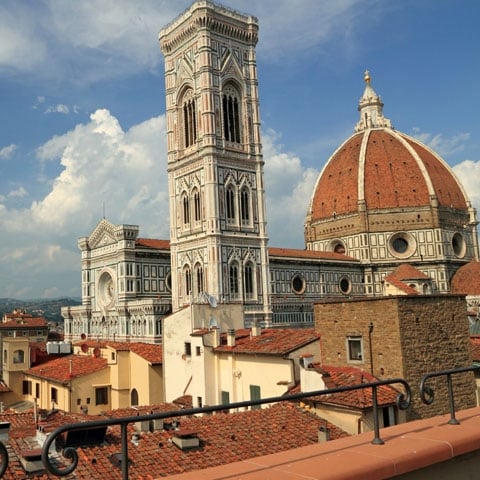 A stroll through Florence can be a moving experience, as there is unparalleled beauty and history to be seen at every turn. The city contains a wealth of architecture in a compact location, allowing all the chance to see many iconic locales.
A stroll through Florence can be a moving experience, as there is unparalleled beauty and history to be seen at every turn. The city contains a wealth of architecture in a compact location, allowing all the chance to see many iconic locales.
The Piazza del Duomo is the cultural heart of Florence. A large square, this is the most visited location in Florence and features such architectural masterpieces as the Cathedral of Santa Maria del Fiore, Giotto’s Bell Tower, and the Baptistery of St. John. The Cathedral of Santa Maria del Fiore, also referred to as the Duomo, is considered to be one of the most beautiful churches in Italy, and its dome was the largest in the world for many centuries. Showcasing Gothic and Renaissance elements, the Duomo represents the flowering of the Renaissance movement and is an indelible symbol of Florence.
The interior of the Duomo is intricately decorated with breathtaking frescoes, sculptures, and stained-glass windows. The massive fresco known as The Last Judgement, which was started by Giorgio Vasari and completed by Federico Zuccari, is just one of the Duomo’s many treasures. Inside the Duomo, visitors will be rewarded with views of stunning masterpieces including frescoes by Paolo Uccello, stained glass designed by Donatello, and a breathtaking crucifix by Benedetto da Maiano.

Giotto’s Campanile or Bell Tower is also part of the Duomo complex. Standing at nearly 280 feet tall and divided into five stages, the exterior of the bell tower is decorated with beautiful bas-reliefs, sculptures, and marble of different colors. A prime example of Florentine Gothic architecture, the tower also offers spectacular views of the city center and surroundings.
The third principal building of the Duomo complex is the Battistero di San Giovanni, or Baptistery of St. John. It is considered to be one of the oldest buildings in Florence and was constructed in the Florentine Romanesque style. Known for its octagonal design, the exterior of the baptistery features colored marble like the adjacent Bell Tower and Duomo. Perhaps the most important feature are the bronze doors decorated with relief sculptures that were referred to as “The Gates of Paradise” by none other than Michelangelo. The East and North doors were designed by Lorenzo Ghiberti, while the South doors were designed by Andrea Pisano. The interior of the baptistery is characterized by the elaborate gold mosaic ceiling present on the inside of the dome. Several key historic figures were baptized here, including Dante Alighieri and members of the Medici family.
Located near Piazza del Duomo, Piazza della Signoria is another important Florentine square. This L-shaped square is home to Florence’s town hall, Palazzo Vecchio, as well as the Loggia dei Lanzi, an open-air gallery, which features stunning arches and Renaissance sculptures.
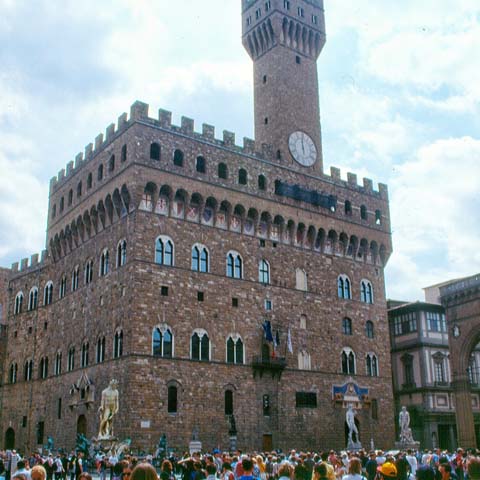 The Palazzo Vecchio, formerly known as Palazzo della Signoria, is the seat of the city’s current government and in the past housed the government of the Republic of Florence. The building dates back to the thirteenth century and is an excellent example of civil Florentine medieval architecture. In front of the building, visitors will find two statues: one is a copy of Michelangelo’s David and the other is Ercole e Caco by Baccio Bandinelli. It is interesting to note that the original David sculpture was on display in Piazza della Signoria until 1873 when it was moved to the Accademia Gallery.
The Palazzo Vecchio, formerly known as Palazzo della Signoria, is the seat of the city’s current government and in the past housed the government of the Republic of Florence. The building dates back to the thirteenth century and is an excellent example of civil Florentine medieval architecture. In front of the building, visitors will find two statues: one is a copy of Michelangelo’s David and the other is Ercole e Caco by Baccio Bandinelli. It is interesting to note that the original David sculpture was on display in Piazza della Signoria until 1873 when it was moved to the Accademia Gallery.
The exterior of the building features arches, the Tower of Arnolfo, and crests representing aspects of the Republic of Florence. Prior to entering the building there are three courtyard areas with barrel vaults. Today, the city council of Florence continues to meet in the Palazzo Vecchio and the building’s function in local government remains intact. However, much of the building is also a museum, allowing visitors from all over the world to admire the rich treasures within.
Inside, travelers will find grand rooms decorated with beautiful frescoes and paintings. One of the most ornate rooms is the Salone dei Cinquecento, which is 75 feet wide and over 170 feet long. The stately room is decorated with large frescoes depicting battles between Florence and nearby rivals Pisa and Siena as well as painted ceiling panels. The building features two floors plus a mezzanine, all of which are filled with historic frescoes, paintings, and sculptures.
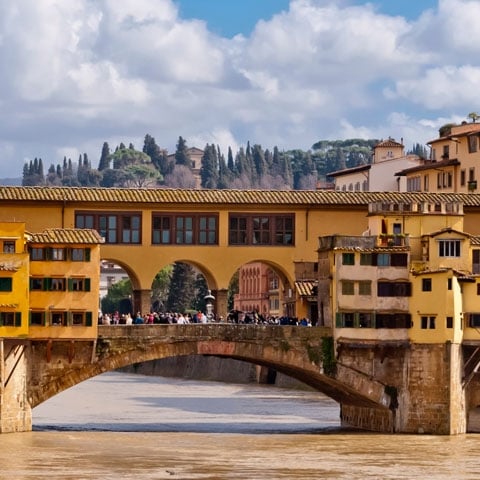 Adjacent to the Palazzo Vecchio, travelers will find the Loggia dei Lanzi. Easily recognizable thanks to its beautiful arches, Loggia dei Lanzi is an open-air museum of sorts featuring several remarkable sculptures. A few of the sculptures on display include Perseus by Benvenuto Cellini, The Rape of the Sabine Women by Giambologna, and The Rape of Polyxena by Pio Fedi.
Adjacent to the Palazzo Vecchio, travelers will find the Loggia dei Lanzi. Easily recognizable thanks to its beautiful arches, Loggia dei Lanzi is an open-air museum of sorts featuring several remarkable sculptures. A few of the sculptures on display include Perseus by Benvenuto Cellini, The Rape of the Sabine Women by Giambologna, and The Rape of Polyxena by Pio Fedi.
In the southern part of the city, curious travelers will find the Forte di Belvedere (Belvedere Fort), which was constructed to protect the government as well as members of the Medici family. Featuring elements of military architecture and the Italian Renaissance style, the fort was once connected to the Palazzo Vecchio by way of the Vasari Corridor.
Architects of the Renaissance were usually also artists, which explains why Florence’s buildings and squares are such masterpieces, boasting outstanding vision and design. Filippo Brunelleschi, the designer of Florence’s legendary dome, was Florence’s most prominent and influential Renaissance architect.
Florence’s beautiful architecture is varied and follows the city’s rich history with the majority of the buildings dating back to the Renaissance, and, to a lesser extent, the Middle Ages. With such a remarkable past, the city is filled to the brim with interesting architecture. In addition to the must-see squares and buildings listed above, there are countless other squares, churches, historic buildings, towers, villas, bridges, and main streets that are all worth a visit. Other notable examples include Palazzo Medici-Riccardi, the Basilica of Santa Maria Novella, the Basilica of Santa Croce, the Medici Chapels, Orsanmichele Church, and more.
CINEMA IN FLORENCE
Italy as a country has made its mark on the world of cinema in a significant way. Florence is no exception.
Legendary movie director Franco Zeffirelli was born in Florence and helped shape the Florentine film culture. Zeffirelli, who began his career directing opera productions in Italy and abroad, was nominated for two Oscars and was best known for his film adaptations of classic plays and operas. Among Zeffirelli’s most celebrated works are the films The Taming of the Shrew (1967), Romeo and Juliet (1968, nominated for an Academy Award), Brother Sun, Sister Moon (1972), Jesus of Nazareth (1977), La Traviata (1983, nominated for an Academy Award), Otello (1986), Hamlet (1990), and Jane Eyre (1996). Zeffirelli often drew inspiration from his hometown and one of his final works, Tea with Mussolini (1999) was filmed in Florence.
Roberto Benigni, another influential Italian director, was born in Florence as well. Primarily recognized in Italy for directing and starring in comedy films such as Il piccolo diavolo (1988) and Johnny Stecchino (1991), among international audiences Benigni is best known for directing and starring in La vita è bella (Life is Beautiful) (1997). Considered to be one of the most critically acclaimed films in the history of Italian cinema, Life is Beautiful won three Academy Awards including Best Foreign Language Film.
Florence is also the home of film director and comedian Leonardo Pieraccioni who has helped capture the playful nature of Florentine people with his family comedies. Like Benigni, Pieraccioni tends to both direct and star in his films, several of which are set in Florence, such as his directorial debut I laureati (1995) as well as Il pesce innamorato (1999). A few of Pieraccioni’s other films include Fuochi d’artificio (1997), Una moglie bellissima (2007), and Se son rose (2018).
As a city with such visual beauty, Florence has been captured by many filmmakers throughout the years. Films such as I vitelloni (1953), Amici miei (1975), A Room with a View (1985), The Portrait of a Lady (1996), The Stendhal Syndrome (1996), Hannibal (2001), The Best of Youth (2003), Il giovane favoloso (2014), and Inferno (2016) all featured the gorgeous city.
FLORENCE’S SCIENCE
Among Florence’s many contributions to the worlds of art, architecture, film, and literature, the city has also made a marked difference on the world of science.
For example, some consider Antonio Meucci, who was born in Florence in 1808 and studied and worked there until 1835, to be the true inventor of the telephone. While the technology was patented internationally by Alexander Graham Bell, Meucci’s original voice communication invention was the first step toward long-distance communications.
Florence’s scientific history also expands to exploration. Amerigo Vespucci and Giovanni da Verrazzano, two famous Florentine explorers, were the first to identify the Americas as new continents.
Finally, though he was born in Pisa, Galileo Galilei moved to Florence with his family as a young boy and would spend the majority of his life in Florence. Florence’s science museum, Museo Galileo, is named in honor of Galileo, and displays many historic scientific instruments as well as unique artifacts tied to Galileo, including his telescopes and even three of the scientist’s fingers.
The influence that Florence has had on the world of art, architecture, and beyond is a testament to its power as a cultural epicenter. The culture of Florence is characterized primarily by its ability to spread beauty and define beauty the world over.
The Tuscany Region of Italy
Cities of Tuscany
Don't just see Italy, live it.
Your dream trip to Italy has never been closer
No more endlessly scrolling travel sites. Our travel experts will craft the perfect, one-of-a-kind trip just for you.

300+
DESTINATIONS
We offer more Italian destinations than any travel site. Do and see more with Trips 2 Italy.
1 (of a kind)
ITINERARIES
Because your dream trip to Italy should be designed for you, not for the masses.
100%
PEACE OF MIND
From flights and accommodations, to food and activities - we take care of every detail.
